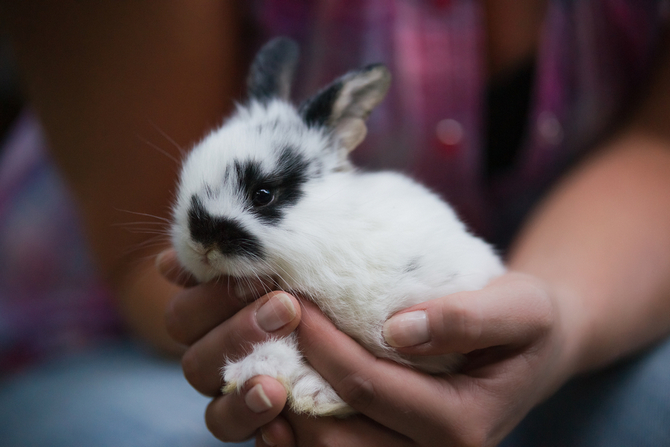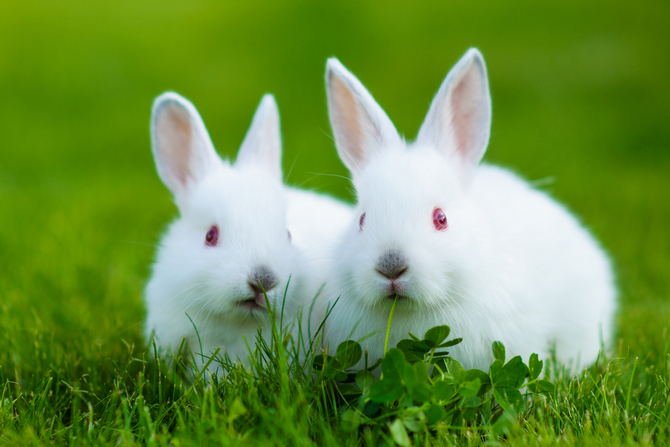The population of wild rabbits in urban areas is high. They prefer to hide their nests in plain view. Probably, they prefer bushes or the middle of your yard, etc. Unfortunately, nests that often appear abandoned are often not. The wild baby rabbits detached from their nests by humans are doubtful to survive without the care of a veterinarian or skilled wildlife rehabilitator. If you witness a nest in a troubled state, try and do the best to restore it and put down the babies there. It is illegal in many states to take care of wild rabbits unless you are a licensed rehabilitator. In that case, if you need to take care of the wild orphaned rabbits you can take them to a wildlife rehabilitator or a vet. Read this article to know more about what to feed rabbits and tips to take care of the little ones.
Once you restore the nest, leave the babies there. However, waiting for the mother to come back will decrease the chances of survival. Mothers only nurse the baby for a few minutes a day and stay away as to not draw predators to the nest. You can help the babies in case of injuries or abandoned by mother’s death by taking them to a wildlife rehabilitator or veterinarian. Before knowing what to feed a rabbit let us know how to prepare a place for the baby rabbit.

Wooden or Plastic Box Prepare a wooden or plastic box with high sides is preferable. Contour line the box with pesticide-free soil followed by a layer of dried hay.
- Make a circular nest out of hay for the babies to stay within. Line it up with disinfected fur if available.
- If you have hair of other pets, shed. Lay the pile of hair from their hairbrush out in the sun to sterilize. It kills the bacteria present in the hair.
- If you are not accessible to hair, you can line up the nest with tissues in a thick layer.
- Place a heated bed, incubator or hot pad below one end of the box. As it is crucial to keep the baby warm. Make sure you are placing only one end so that if the baby feels too warm it can always move away.
What to Feed a Baby Rabbit?
Feed it the Kitten Milk or Baby Rabbits Puppy Twice Per Day: Mother rabbit feeds the babies only two times a day for five minutes each time. It feeds the babies during dusk and dawn. Therefore, baby rabbits depending on the size only need to be fed two times a day.
Feed the kitten or rabbits puppy milk available from a pet supply store. Add a little probiotic to the milk to take care of their tummy’s health. Warm the milk slightly and use a dropper to feed the baby in a sitting posture. Take care so that the baby does not aspirate.
Note: Never feed cow’s milk to the baby.
Never Overfeed a Baby Rabbit: Overeating is one of the common causes of death in bunnies. Excessive eating causes bloating. The quantity of each feeding depends on the age of the baby rabbit. Cottontail Bunnies are smaller so take care to feed them less. Let us see the general guidelines on feeding amounts:
- For newborn up to one-week-old feed 2-2.5 cc/ml, twice per day
- Between 1-2 weeks 5-7 cc/ml each time, two times per day (if the rabbit is very small feed less)
- From 2 -3 weeks increase up to 7-13 cc/ml each feeding, two times per day (if the rabbit is very small feed less)
- Also between 2-3 weeks, you can introduce them to pellets, timothy hay, oat hay, and water. Further, you can add fresh greens for wild rabbits.
- Between 3-6 weeks, rabbits may be fed about 13-15cc/ml in each feeding twice per day (if the rabbit is very small feed less)

Right Time to Stop Feeding the Formula
Cottontail Bunnies usually wean around 3 to 4 weeks. Do not feed the formula past six weeks. Wild Jackrabbits wean past nine weeks. You can replace the formula after nine weeks with a dish of cut up apple and tiny bananas.
How to Feed a Newborn Rabbit?
While feeding the bunnies, be careful and follow the below tips:
Handle the babies with care, they lie on their back when the mother feeds them. When you are feeding the baby, wrap the baby with a soft hand towel or face towel. Place the baby on your lap or in the crook of your arm. Do the best you can to feed the baby. Allow the baby to eat at its pace. Don’t squirt the liquid too quickly as this may aspirate the lungs of the baby and lead to suffocation.
Be gentle and slow as bunnies have their pace, be very gentle in handling them. If you try to feed them too fast, it may choke them and cause them to die.
Place the bottle’s teat in the bunny’s mouth. Be very careful to place the teat of the bottle in the newborn bunny’s mouth and ensure nothing goes wrong.
- Tilt the bunny backward a little and proceed to place the teat between its side teeth. Just to remind you that it is impossible to insert the teat directly in between their front teeth.
- Once the teat is placed in between the side teeth, proceed to slide it around to the front.
- Squeeze the bottle gently thus allowing only a small amount of formula to come out of the teat.
- Within a few minutes, the baby rabbits start sucking the milk.
- Feed the same formula for 3-4 days, two times a day. Make sure the last feeding is at dusk as the mother would do.
To keep the baby’s gut healthy and free from bacteria, you can get a bottle of Acidophilus from local health food store. Capsules with “grainy stuff” inside are also available. The capsules mix easier than the powder. Add a bit with each formula feeding.
Stimulating Rabbits’ Bowels
The baby cottontails need stimulation for poop and urinating following the feed. Gently stroke the baby rabbit’s anal and genital area with a cotton ball or moist q-tip to resemble the mother rabbit's lick. It is important for the baby to defecate and urinate after each feed. Until the babies open their eyes (say for about ten days) it is important to stimulate and run the defecation system smoothly. The stool will be soft and in shades of yellow and green. If you find the urine brown and dirty, then the bunny is not adequately hydrated, in that case, consult the vet immediately (it is an emergency). Always be sure to clean the mouth of the baby with a paper towel or damp cloth after each feeding. Make sure no milk dries in the hair.
Baby rabbits start opening their eyes after ten days. Start introducing the bunny to hay and pellets at this stage. But make sure you will not feed them with any fruits and veggies. Leave some pellets, timothy or orchard and alfalfa hay in a corner of the box where the babies can reach easily. Make sure the pellets you provide are plain, fresh and high in fiber, and there are no added goodies like seeds or banana chips. Use a shallow dish and rinse it frequently.
Allow Bunny to Spend Time Outdoors
As the baby rabbits start walking, allow them to spend time outside on a grass lawn. Keep them in a wire cage so as to protect them from predators and any other threat.
Let the Bunny Learn to Feed and Drink Unassisted
When the baby rabbits are four days older, place a small flat container lid with water and one more container lid with formula in their hutch.
Keep an eye on the babies to make sure they are feeding on the formula and drinking the water.
Make sure the formula is not spilled and the hutch isn’t wet. Replace the appropriate amount of formula so that the baby gets the exact amount needed.
Replace the water and formula every morning and evening. Make sure the rabbit is not overfed.
Do not place a dish with deep water near bunnies. Bunnies may drown in the water.
Introduce New Foods
After four days, introduce new foods once the bunnies get mastered in eating the formula and drinking the water without any assistance. You can leave other treats for rabbits in their hutch. The treats may include:
- Pieces of Apple
- Clover Hay
- Oats
- Small Pieces of Bread
- Fresh Picked Grass
- Timothy Hay
- Dry hay looking grass
Fresh Water:
Make sure bunnies will have access to clean and fresh water all the time. Water keeps them hydrated, healthy and improves digestion.
Wean Off the Formula
When the the bunnies feel they are self-sufficient, you can wean them off the formula. You can allow them to feed on grass and other vegetation. The appropriate weaning age for bunnies is 3 to 5 weeks for cottontails and 9+ weeks for wild jackrabbits.
Stop Handling the Bunnies
Stop touching the bunnies and make them self-sufficient. At this stage, they are prepared to be released into the wild. Now the bunnies are no longer dependent on you.
Move the Bunnies Outdoor Full Time
Keep them in a wire cage outside your house with a roof. Make sure the bottom of the cage is wire thus the rabbits can graze. Ensure the holes are not big enough to slip through it.
- You can move the cage around your yard. Bunny gets new vegetation every day.
- Along with grass supply extra vegetation
Shift Them to Larger Hutch
Shift the bunnies to the larger hutch outdoorson the grass and ensure the bottom is open or made of wire. Continue providing extra veggies two times a day along with the grass. Make sure the bunnies are safe from predators.
Release the Bunnies
If your bunnies are about eight to nine inches in length in the sitting posture, they are quite big enough to be released into the wild. Now the wild is the safe place for the bunnies. If the bunnies are not able to take care of themselves, you can keep them for a longer time. However, do not keep them in captivity till they attain maturity.
Call Wildlife Conservation
Call the local Wildlife Conservation if the rabbit is big enough to release but still not self-sufficient. Experts will take care of the situation.
I hope I have answered your question about what to feed a baby rabbit correctly. If you have found it useful and wished to express your response, please drop them in our comments section. Let the world know it is a great experience to take care of pets.